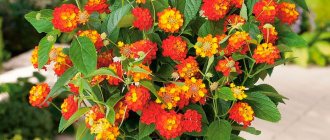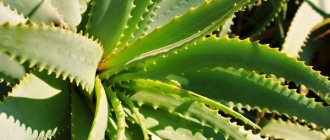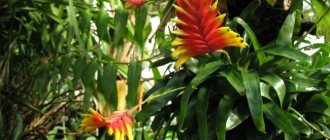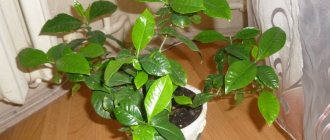Flower growers are “domesticating” more and more new exotic plants that attract attention with their decorativeness and unusualness, adding comfort and originality to the interior. Succulents are especially popular (not least because of their modest size and unusual appearance), standing out even in the largest collection of indoor plants. These include pedilanthus, which from a distance can easily be mistaken for an artificial flower - its shiny, smooth leaves seem to be made of plastic. The features of caring for it at home will be discussed further.
How does Pedilanthus grow?
Pedilanthus has the shape of a bush, and its stems do not branch at the bottom. The formation of the crown and lateral branches is observed in the upper part of the shoots. For planting, it is recommended to use a light soil mixture.
Interesting materials:
How to use the remote control on Xiaomi? How to use Xiaomi selfie stick? How to use a paper clip? How to use wax and seal? How to use the DPD terminal? How to use a USB modem? How to change ava in a contact from an album? How to change the battery of iPhone 5s? How to change a disc on an angle grinder with a key? How to change the background image?
Planting and transplanting procedure
Too often they try not to disturb the pedilanthus, replanting it again only when the roots appear from the drainage hole of the pot. The root system develops quite slowly, so once every 3–4 years is enough, even for the youngest, fastest growing flowers. The best time for replanting is mid-spring, when the plant has already begun to form new leaves.
The pot for pedilanthus is chosen to be low and cramped. The diameter of the new container (compared to the previous one) increases by 1–1.5 cm, no more, the height does not change. In general, the height and diameter of the pot should approximately coincide with each other. The preferred materials are natural ceramics - they allow air and moisture to pass through well. For the same reason, it is important to have a large drainage hole.
Pedilanthus are planted in special soil for cacti and succulents. Or prepare the substrate yourself. The main requirement for it is lightness, friability, air and water permeability. Nutritional value isn't that important.
- Fertile turf, leaf soil, coarse river sand (1:2:2).
- Peat chips, universal soil for flowering indoor plants, fine red brick chips, perlite or vermiculite (3: 3: 2: 2).
- Fertile turf, leaf humus, crushed coconut fiber or dry sphagnum moss (1:1:3).
Pedilanthus is transplanted as follows:
- Pour expanded clay or other drainage material into the new pot in a layer 2–3 cm thick.
- Fill the container halfway with fresh sterilized soil.
- Remove the pedilanthus from the old pot and gently shake off the soil from the roots. There is no need to try to expose them completely or wash off the substrate.
- Carefully inspect the roots and use sharp, disinfected scissors to trim off any roots that are dry, dead, blackened, or slimy to the touch. On rotten ones, cut off not only the slightest traces of blackness, but also an additional 3–5 cm. Most likely, pathogenic fungi have managed to spread there too.
- Place the flower in a new pot, add soil around the edges. Shake the container several times and lightly water the plant.
- Place the pedilanthus in a warm, dark place for 7–10 days. This will help minimize stress and settle in better. Then return the pot to where it was before and care for the plant as usual.
Store-bought pedilanthus should be replanted as quickly as possible.
Succulents look very impressive in florariums. If you have a suitable glass container of the required size, it is easy to create such a composition yourself.
- Thoroughly wash and disinfect the selected vessel by wiping it outside and inside with alcohol. Sterilize the substrate.
- Place a 1–1.5 cm layer of drainage on the bottom of the container, then the same amount of sifted wood ash, crushed into powdered activated carbon. If it is large enough, you can put in a few pieces of coal without crushing it. This is effective protection against mold and rot.
- Place the substrate on top. The thickness of the layer depends on the depth of the container (2 cm or more). Level the soil and prepare a hole for the pedilanthus.
- Rinse the roots of the selected plant, soak in a 1% solution of any fungicide for 10–15 minutes. When the root system is dry, you can plant it.
- Lightly moisten the soil using a watering can with a long spout or a regular syringe.
- Decorate the composition. Multi-colored sand or pieces of glass, pebbles, pebbles, moss, bark fragments, and small figures are suitable for decoration.
- Using a soft brush, brush the glass from the inside, removing soil particles.
If the florarium is closed, do not forget to periodically remove the lid, especially if condensation has already formed on the walls. High humidity provokes the development of rot. It is much more destructive for the composition than excessive dryness. Therefore, water the plants rarely and little by little.
The florarium does not last forever, although succulents grow rather slowly. Even regular pruning will not help preserve the composition forever. Pedilanthus that have outgrown the container must be promptly planted in pots of suitable size.
Temperature
In spring and summer, the optimal temperature for pedilanthus is 20-26 degrees. It can withstand temperatures up to 30 degrees for a short time, but only if the room is frequently ventilated.
Pedilanthus is afraid of sudden changes in temperature and drafts, so when ventilating it is better to move it away from the window.
In winter, the plant feels most comfortable at 14-18 degrees: such conditions ensure abundant flowering. Too high a temperature causes the stem to stretch and leaves to fall off.
Frequently asked questions from flower growers
Lifespan of a plant?
It is a perennial plant, but over the years the lower leaves fall off, exposing the stem, which negatively affects its appearance.
Is it possible to keep this plant at home?
The flower tolerates room temperature well and looks original in the interior of any room.
Is this flower poisonous?
In the flower, only its juice is poisonous. The stem, leaves and flowers are completely harmless to humans.
Why doesn't the flower bloom?
The lack of flowering in Pedilanthus can be caused by high temperatures and dry soil.
Why do the leaves turn yellow (dry) and fall off?
This problem can arise due to improper watering, excess or lack of lighting.
Why do the leaves turn red?
Pedilanthus leaves may turn red if the air is too dry.
Possible diseases
Dyschidia: description, types and care at home
In addition to the fact that the plant’s leaves may darken or fall off, all kinds of insect pests can attack the indoor flower:
- aphids (tiny greenish insects that settle on young leaves, as a result of which their development stops and their death occurs);
- spider mite (the leaves of the flower begin to turn yellow and a white cobweb appears on the back side);
- whitefly (the leaves turn yellow and begin to stick, white midges settle on them).
Important! Any insecticide is suitable for controlling insects.
Leaf fall
A common problem is that Pedilanthus variegata and other species of this plant begin to lose leaf mass. The main reason is improper care of the flower - too frequent or infrequent irrigation of the soil, scorching sun. It is necessary to find the cause of the disease and eliminate it.
The leaves are turning pink
Fungal diseases and root rot are considered common diseases of pedilanthus. The first symptoms are the appearance of dark pink spots on the leaves and darkening of the stems. If such signs occur, you should immediately change the soil mixture in the pot, and thoroughly rinse the root system with warm water and treat it with special antiseptics.
Plant diseases
If in winter it is noticed that the stem of the pedilanthus begins to grow quickly, this means that the plant is very hot and dark. If the flowering phase does not occur, this indicates that incorrect conditions were created during the dormant period. Dry brown leaf tips are a signal of low air humidity, and very light tips indicate insufficient lighting.
The indoor flower has medicinal properties. It is used in medicine as an antimicrobial agent. However, if you decide to care for a flower, you should be careful. The sap of the plant is toxic and leaves minor burns upon contact with exposed skin. Otherwise, there will be no other problems with pydelanthus.
LiveInternetLiveInternet
—Categories
- ORTHODOXY (14)
- HANDMADE (14)
- beads (1)
- BUSINESS, FINANCE (0)
- IN THE WORLD OF ANIMALS (0)
- EVERYTHING FOR CHILDREN (2)
- EMBROIDERY (1)
- KNITTING (359)
- compilations (333)
- crochet (8)
- for women (4)
- for men (2)
- master classes (2)
- patterns (2)
- children (1)
- FOR THE COTTAGE AND GARDEN (206)
- BEAUTY and HEALTH (90)
- diets, weight loss (27)
- good for health (23)
- face masks (1)
- traditional medicine (35)
- hair care (5)
- foot care (1)
- COOKING (4030)
- collections of recipes (499)
- pies, pies (255)
- poultry dishes (232)
- for dessert (221)
- baked goods (130)
- pancakes, pancakes (115)
- main courses (113)
- minced meat (107)
- jam (97)
- sauces, dressings, marinades (78)
- vegetable dishes (73)
- cottage cheese dishes (59)
- for breakfast (58)
- from offal (57)
- for Easter (55)
- Lenten dishes (47)
- dough (45)
- side dish (42)
- pasta and cereals (31)
- pizza (29)
- culinary tricks (25)
- recipes with lavash (24)
- egg dishes (19)
- sausages, dishes with sausages (14)
- fast food (10)
- for multicooker (8)
- cheeses (2)
- fish dishes (155)
- dishes with mushrooms (44)
- winter preparations (222)
- snacks (235)
- casseroles (74)
- potato dishes (125)
- porridge (28)
- shrimp, squid, seafood (23)
- meat dishes (156)
- drinks (100)
- food decoration (1)
- salads (231)
- sweet pastries (38)
- soups (196)
- cakes (107)
- HOLIDAYS (34)
- New Year (12)
- Christmas (9)
- Easter (7)
- Valentine's Day (2)
- February 23 (1)
- March 8 (1)
- MISCELLANEOUS UTILITIES (18)
- SPORTS (2)
- COMFORT IN THE HOUSE (180)
- indoor plants (176)
- SEWING (1)
- ESOTERICA, MAGIC, ASTROLOGY (12)
- THIS IS INTERESTING (6)
Watering
In the hot season, pedilanthus needs abundant watering - 3-4 times a week.
The soil in the pot should always be slightly moist. In winter, the frequency of watering is reduced to once every 5-7 days, but the soil should not dry out.
A signal for the next moistening is a decrease in leaf turgor. If there is insufficient watering, the flower may lose its leaves altogether.
Water for irrigation should be settled or filtered, at room temperature.
Features of growing Pedilanthus - a brief description. Complexity, whimsicality, accessibility
Pedilanthus, like any indoor plant, needs certain conditions that will promote its growth and flowering. The list of necessary conditions should include:
- optimal lighting conditions;
- suitable temperature conditions;
- proper watering;
- ambient air humidity;
- feeding with fertilizers.
Growing this tropical plant is not difficult.
With proper care, the flower will develop harmoniously and bloom regularly. The optimal place to install a flower can be rooms on the south side. Today anyone can decorate their home or apartment with Pedilanthus. The flower can be found in almost any specialized flower shop. In addition, the flower can be bought in both small and large sizes. Attention, possible difficulties : in winter, the flower can stretch upward. This occurs due to insufficient light and high room temperature.
Plant pruning
In addition to watering, maintaining temperature conditions and feeding the plant, Pedilanthus must be pruned. A correctly performed pruning procedure at home has a beneficial effect on the branching of the flower crown. The pruning operation must be performed with a sterile knife. At the final stage, the cutting areas must be treated with charcoal or sulfur. This will help the plant to tighten the cut site faster.
Trim time
Experts recommend pruning Pedilanthus in two cases.
- When rejuvenating a strengthened flower, shoots that have lost their decorative effect are removed from the stem. Pruning must be done so that a stump of 5-6 centimeters remains.
- After replanting, the lower leaves that are in the way or located too low to the ground are cut off.
The pruning rules for both the first and second cases are the same.
Advice: Pedilanthus should be pruned regularly when it is young. This is the only way to achieve strong branching in a flower.
Reproduction
Pedilanthus propagates by cuttings. In the spring, when the plant is formed by pruning, a large number of apical cuttings remain ready for rooting. Cuttings are rooted in water, sand or perlite.
The cuttings are not given a greenhouse, as happens with cuttings of other plants. On the contrary, to prevent rot from forming, the container with the cuttings is left open.
The length of cuttings for rooting is at least 10 cm. There is no need to make them too long. Rooting time is from two weeks to a month. When the plant forms roots, the cuttings are planted in a substrate made up of sand and peat in equal proportions.
Good to know
Pedilanthus is a spurge plant, so when pruned it produces a milky sap. Before rooting, let the cuttings sit for 1–2 days to dry.
Seed propagation of pedilanthus, due to its labor-intensive and ineffective nature, is not used in indoor gardening.
Home care
One of the reasons for the prevalence of this indoor plant is its ease of care. Pedilanthus titimaloides loves well-lit rooms, but does not tolerate prolonged exposure to the sun. Usually in rooms it is placed either in the east or in the west.
Temperature conditions are also very important for the full development of the flower. During the summer months it can be placed on a balcony or gazebo as it loves fresh air. In winter, as well as in the first months of spring, it is better to place pedilanthus in an enclosed space (room), the temperature of which will be approximately +23.25 degrees.
It must be taken into account that pedilanthus does not tolerate drafts and air with low humidity levels. This can cause the plant to shed a large amount of foliage. If a flower sheds a few leaves, this is quite acceptable for it, especially in the winter season.
In winter, the flower enters a so-called dormant state; during this period, watering is slightly reduced compared to watering in the summer and autumn months. In summer, pedilanthus must be watered as soon as the soil begins to dry out. The water should be settled and at room temperature. Periodically you need to take a “shower” with a spray bottle of water or a mixture of fertilizers. It is best to feed the plant with additional microelements at least once a month. The main thing is that the composition does not contain nitrogen components, which are poisonous for this type of flower.
The soil for the flower must be mixed from several components - turf soil, leaf soil and regular sand. It is necessary to lay a layer of expanded clay at the bottom of the pot, which will prevent water from stagnating in the soil and rotting of the plant’s root system.
For normal growth and development, pedilanthus needs to be systematically pruned, that is, the removal of lateral branches. Thus, the plant will always look well-groomed and healthy. After this procedure, the flower does not need to be moistened, but only treated with sulfur. Branches must be trimmed with sharp garden shears.
Where to put
Pedilanthus prefers bright, diffused light, without direct sunlight. The best window for it is east or west. Preferable, of course, is the south. In summer, it is advisable to place the plant in a bright place (shading from direct sun). In the warm season, pedilanthus can be taken out into the open air (balcony, garden), but should be protected from direct sunlight and precipitation.
You don't have a balcony or a garden and you can't provide your plant with a sweet life? Ventilate your home more often, let air flow freely to the plant.
And if its leaves turn pink, you know that you are doing everything right!
It's not easy to describe!
Ruellia: description, types and care at home
This is because pedilanthus of different species are sometimes so different from each other - it’s hard to believe in their relationship! Although all plants belong to the same family, and even one genus - Euphorbiaceae. Natural pedilanthus include shrubs and herbs, true leafless succulents and even small trees.
The birthplace and distribution area of the genus are both Americas, especially South and Central. Of course, now they are common in many regions of the planet, but here pedilanthus are already immigrants.
All pedilanthus have one thing in common, the pride of the genus: their flowers. They resemble in shape small high-heeled ladies' shoes, mostly pink in color (in nature). These flowers gave the plant its name, because it consists of two Greek words: pedilon and anthos, meaning “shoe” and “flower” in translation.
Flowers in indoor conditions appear mainly in winter, which makes pedilanthus a particularly valuable houseplant.
There is no point in describing the remaining parts of the crown, they can differ so much. But, in fact, in indoor collections there is predominantly one species from the entire genus - Pedilanthus tithymaloides (
Euphorbia tithymaloides ).
It has large, lanceolate leaves, slightly pointed towards the end, having both green and variegated colors: depending on the variety and even growing conditions.
The branches are thickened, green or brownish, intricately curved in a zigzag shape. As soon as a new leaf appears on the stem, the direction of growth of the branch changes slightly. For this form in America the plant received the nickname Jacob's Ladder. Probably, that’s what the optimists called it, but the pessimists looked at the matter differently and gave the plant a different nickname - the Devil’s Backbone. This is how the diversity of these euphorbias is reflected in two nicknames that are completely different in meaning.











